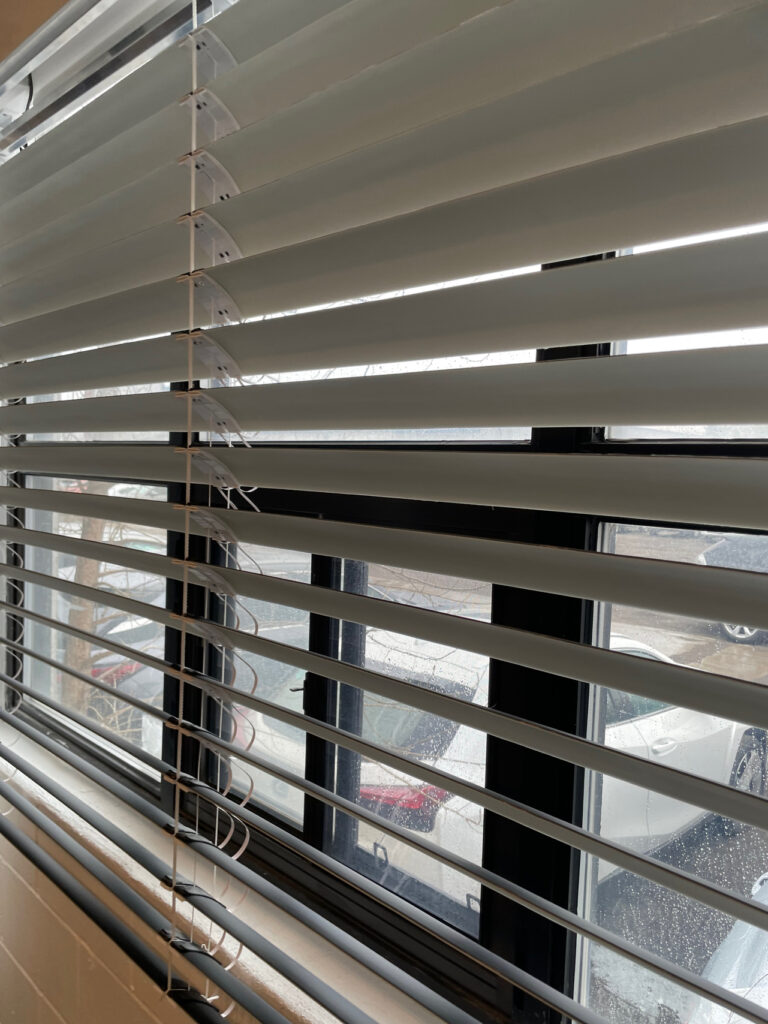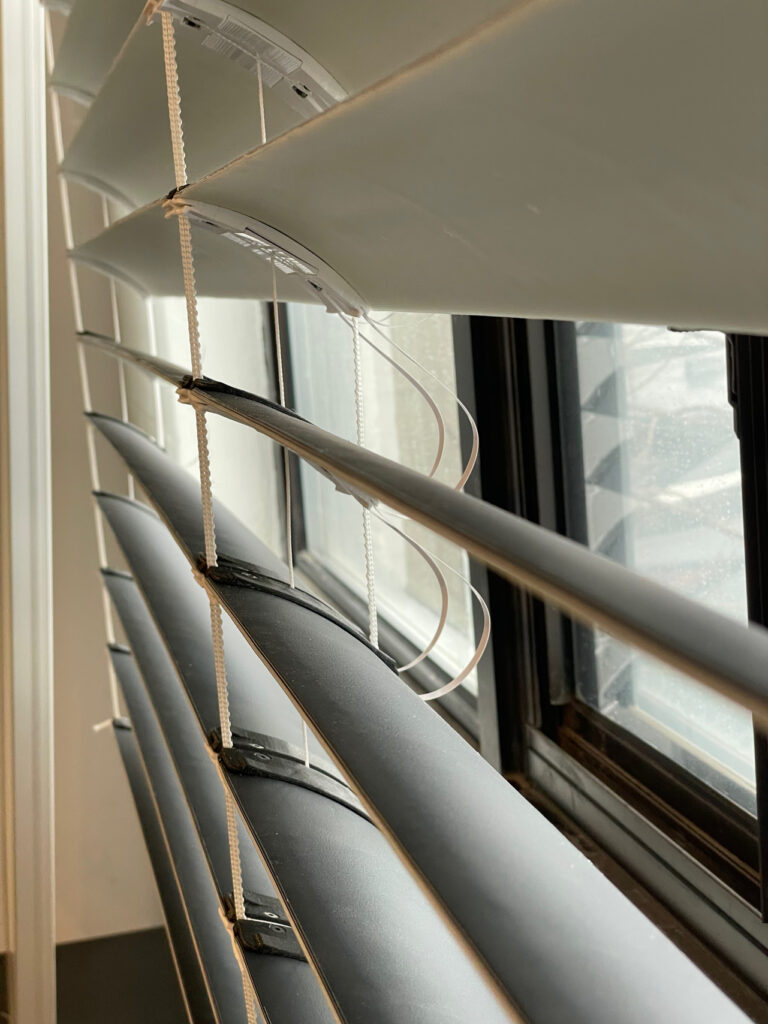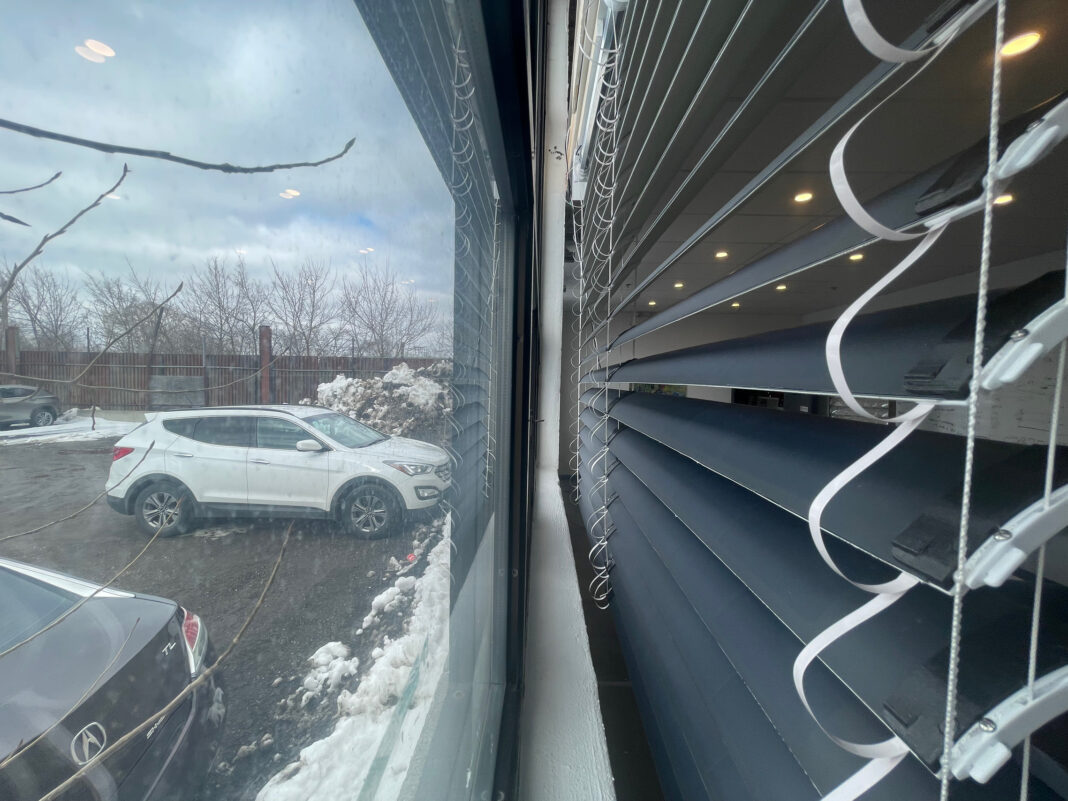A Toronto-based company’s innovative design for window blinds harnesses the sun while keeping buildings cool.
Venetian blinds are a popular choice for privacy and to shade room interiors on sunny days. But Morgan Solar, a small Canadian company based in Toronto, has given the popular window blind a new twist that could dramatically reduce the carbon footprint of large buildings such as high-rises.
Energy Blinds, the company’s latest invention, look no different from most blinds found in homes and office buildings. They consist of a small electric motor tucked away in the ballast, or top rail, at the top edge of the window, and horizontal slats that block sunlight. The motor’s gears raise and lower the blind and angle the slats.
The difference is the slats themselves. Each one is a miniature solar panel connected to its neighbours via an electrically conductive ribbon. A standalone microcomputer (the controller) runs an algorithm that collects solar data and automatically instructs the motor to position the slats to reduce the sunlight entering the room and maximize solar uptake. “To be successful, they need to be great blinds first, and blocking glare is something every blind needs to do well,” says Nic Morgan, Morgan Solar’s vice president of business development.
Energy Blinds were conceived in response to an “innovation challenge” issued in 2020 by Global Affairs Canada. The federal department was renovating one of its buildings and wanted the revamped version to align with the Federal Sustainable Development Strategy, which mandated all federal government departments to reduce their GHG emissions through energy efficiency and begin the transition to clean energy sources. Global Affairs sought proposals for window coverings that “can prevent glare, heat gain in the summer, and heat loss in the winter while also converting solar power to electricity.” Morgan Solar’s proposal was successful.


– Courtesy of Morgan Solar
Morgan Solar was no stranger to innovation. Thirteen years earlier, Nic’s brother, an electrical engineer named John Paul Morgan (today the firm’s CTO), had founded Morgan Solar in 2007 to develop a new, more efficient type of solar panel. After three years of research and development, he devised a novel panel design that resembles solid glass bubble wrap. It was amazingly efficient. But when prices for solar photovoltaics steadily dropped between 2010 and 2015, the brothers’ panels couldn’t compete with those that China and other countries were manufacturing at a dizzying pace. So when the brothers saw the Global Affairs innovation challenge, they knew they were well positioned to meet the need. Within eleven months, they developed and tested a prototype that met all the criteria.
But Energy Blinds wouldn’t live up to their name if they didn’t also crank out power. To gauge their product’s ability to do this, in February 2024 Morgan Solar installed four Energy Blinds in an upper-floor room in a downtown Toronto office building. The blinds were hooked up to Power Over Ethernet, or PoE, a common office networking system whose cables can carry digital data and electricity for phones, computers, printers, clocks, lights, and other low-voltage devices. In this case, PoE also powered the blind motors. Another PoE cable distributed the power output from blinds to the office network. Measurements showed that the blinds cranked out a maximum of 446 watts of power and between 325 and 350 watt-hours of electricity, about four percent more than the devices in the office were drawing.
If you’re thinking that’s not much electricity generation, you’d be right. But consider this: according to Natural Resources Canada, there are over sixteen million dwellings and 482,000 commercial and public buildings in the country. Together, they are responsible for some thirteen percent of Canada’s annual greenhouse gas emissions, mostly due to the need for heating and cooling. Operators of large buildings and institutions use sophisticated control systems to regulate interior temperatures and optimize energy use, but in terms of energy management, high-rise office towers, apartments and condominiums are particularly problematic. Their hundreds or thousands of glass windows are a major source of heat loss in winter and heat gain in summer.
It’s in these tall buildings where Morgan Solar’s Energy Blinds have the potential to shine. Although the product hasn’t yet seen its first large-scale installation, the company can model what could happen in one. For one case study, the company used 3D plans for the J.P. Morgan Chase Tower, a prominent 47-storey skyscraper in downtown Manhattan. Using Sun Studio, software they developed in-house to design and predict the performance of solar installations for buildings, Morgan Solar staff demonstrated how much power the Big Apple structure would theoretically be able to generate if its roof was equipped with solar panels and most of its sun-facing windows with Energy Blinds integrated into the building’s energy system via PoE. The result? In a year, the roof solar would generate 100 megawatt-hours, a respectable figure, but much less than the blinds on the large surface area on the facade, which would generate 300 megawatt-hours. Over the year, the blinds would reduce the amount of electricity needed to power the building’s HVAC and lighting systems by 750 megawatt-hours, equivalent to the annual electricity consumption of approximately 67,000 average Canadian homes.
In terms of energy management, high-rise office towers, apartments and condominiums are particularly problematic. Their hundreds or thousands of glass windows are a major source of heat loss in winter and heat gain in summer. It’s in these tall buildings where Morgan Solar’s Energy Blinds have the potential to shine.
And that’s just in one building. Now imagine Energy Blinds in all the skyscrapers in downtown Toronto, Calgary, Vancouver, and New York. That’s a lot of windows — and potentially spectacular energy savings. It’s also good news for building managers who want to keep their operating costs as low as possible or who are looking for ways to create a net-zero building.
“The negawatts [energy savings gained from energy-efficiency improvements] are worth more than the megawatts in a system like this,” explains Nic Morgan. “But the potential on the facade of a typical tall building like this, with a huge façade and relatively small roof area, is an order of magnitude greater when you combine the energy efficiency plus the generation potential compared to [just] a rooftop array.”
Not only can Energy Blinds produce impressive savings, their design also solves a problem that has plagued others who tried to manufacture similar products — that is, the solar panel layer detaching from the slat over time. “We’ve really separated ourselves from other people who’ve tried to do this by coming up with really cost-effective ways to make the PV slat in a way that eliminates some of the normal delamination issues that a lot of other people strove to overcome,” explains Nic Morgan.
He says the next step is to install Energy Blinds in pilot locations and gather operational data and customer feedback ahead of a formal product launch later in 2024. As the product gains traction, versions for residential windows, condos, and other applications will follow.


